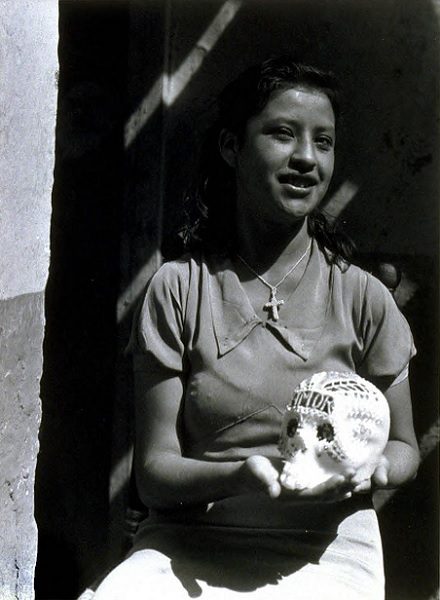
Manuel Álvarez Bravo
Mexican, 1902-2002
Dia De Todos Muertos, 1933
gelatin silver print
9 1/2 x 7 in.
SBMA, Gift of Mr. Rudolph Demasi
1979.69.8

Undated Self-Portrait
"Shoot what you see, not what you think." - Manuel Álvarez Bravo
COMMENTS
Manuel Álvarez Bravo (1902–2002) spent nearly eight decades, from the 1920s to the 1990s, photographing his native Mexico. A self-taught artist who achieved widespread recognition in his lifetime, Álvarez Bravo began his career in the years following the Mexican Revolution (1910–1920), during a period marked by modernization, internationalism, and cultural renewal. Many of his photographs display a keen awareness of the incongruity between traditional customs and modern life in fast-changing urban centers like Mexico City. In 1927, Álvarez Bravo met photographer and activist Tina Modotti, who introduced him to a circle of artists and intellectuals that included Edward Weston, José Clemente Orozco, Diego Rivera, and Frida Kahlo, whose portrait he made on several occasions.
Some of Álvarez Bravo’s earliest pictures were formalist studies of folded paper and abstracted close-ups of everyday objects. When he expanded to other subjects—from votive images and religious artifacts to rural landscapes and sidewalks crowded with pedestrians— Álvarez Bravo brought to them a poetic sense of light, composition, and perspective that privileged mood and metaphor over documentation. He had an eye for evocative associations and gave many of his works lyrical titles that enhance their air of secret significance.
Álvarez Bravo’s work was celebrated by André Breton, the founder of Surrealism, and by poets like Xavier Villaurrutia and Octavio Paz. Villaurrutia called Álvarez Bravo a “poet of the image,” asserting that his best photographs “confront us with veritable representations of the unrepresentable, tangible proofs of the invisible.” The charged, atmospheric quality of Álvarez Bravo's images is often achieved through dramatic contrasts and dynamic lines, but he was also a master of subtle textures and rich middle values. His photographs established a distinct visual identity for Mexico—one full of nuance, intimacy, and silence.
- "Manuel Álvarez Bravo: Mexico’s Poet of Light", Frye Art Museum, September 23 – December 31, 2017
http://fryemuseum.org/exhibition/6698/
SBMA CURATORIAL LABELS
Despite establishing himself as Mexico’s most celebrated photographer by the 1930s, Manuel Álvarez Bravo’s work remained localized for decades and only received mainstream attention in 1971, when the Pasadena Art Museum opened his first major show in the United States. Fred Parker, the Santa Barbara Museum of Art’s future curator of photography, organized this landmark exhibition that traveled to the Museum of Modern Art, New York. Álvarez Bravo was largely self-taught, but had benefitted early on from a friendship with Italian photographer Tina Modotti, who introduced him to American photographer Edward Weston, as well as a circle of avant-garde Mexican artists, such as Diego Rivera, Frida Kahlo, Rufino Tamayo, David Alfaro Siqueiros, and José Clemente Orozco.
Álvarez Bravo’s photographs—created in the wake of the Mexican Revolution that spanned 1910 to 1920—make everyday objects appear unfamiliar through abstraction, and render otherwise unremarkable street scenes dreamy and poetic. Taking cues from Cubism and Surrealism, these works discard documentary style forthrightness in favor of a lyrical though sometimes unsettling sensibility, visually enforced by dramatic contrasts in light and dark, dynamic lines, and rich middle tones. In spite of his international influences and ever-changing Modernist style, Álvarez Bravo remained steadfastly committed to Mexican subjects, including religious festivals such as the Day of the Dead, the lives of farmers and the landscapes they lived in, and indigenous customs that persevered in the face of modernization. The photographs displayed here, two of which are from an album of images documenting the 1971 Pasadena exhibition, range from iconic to lesser-known to singularly local, but are united by the artist’s unique vision that illuminates the quiet oddities of everyday life.
- Crosscurrents, 2018
